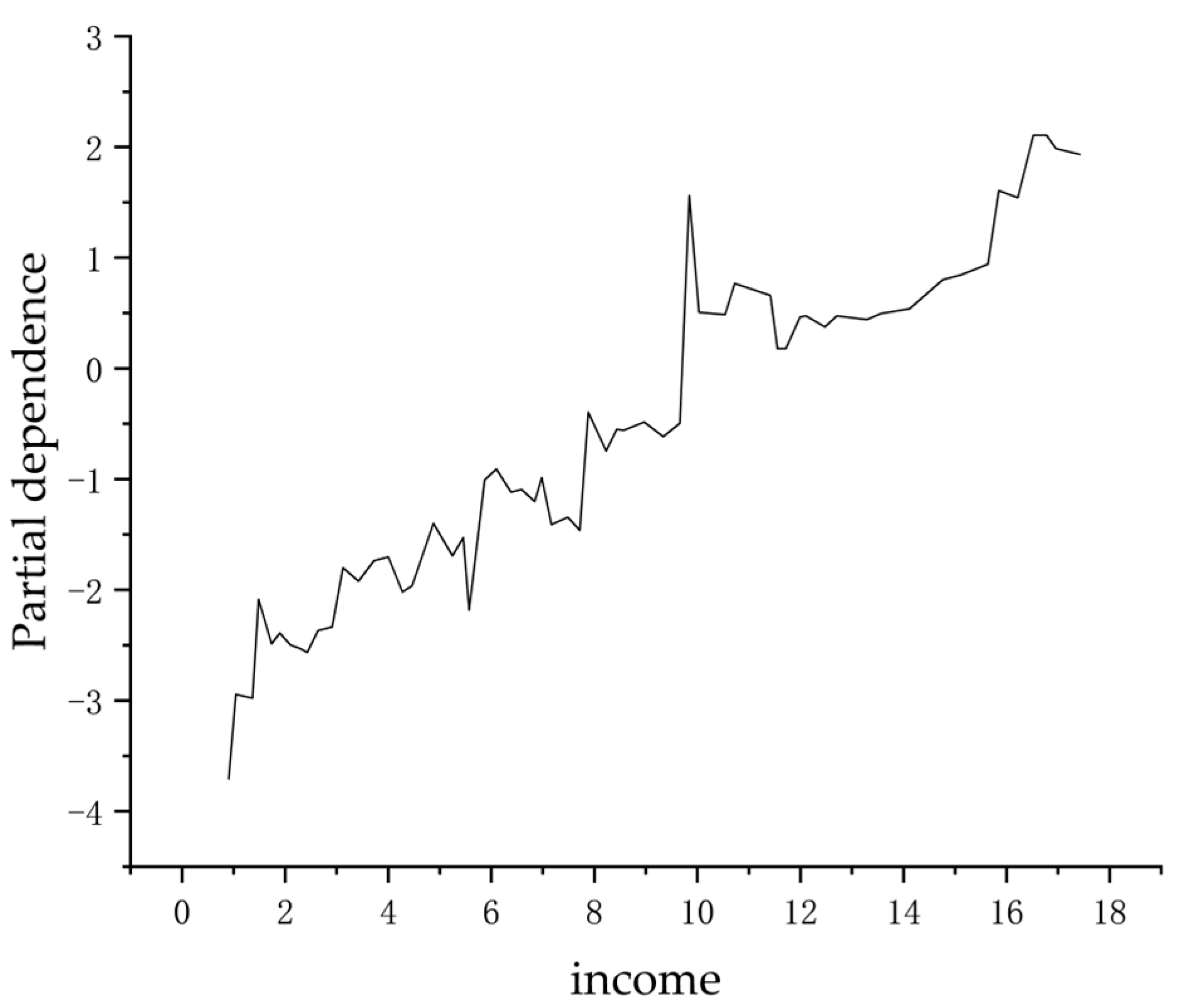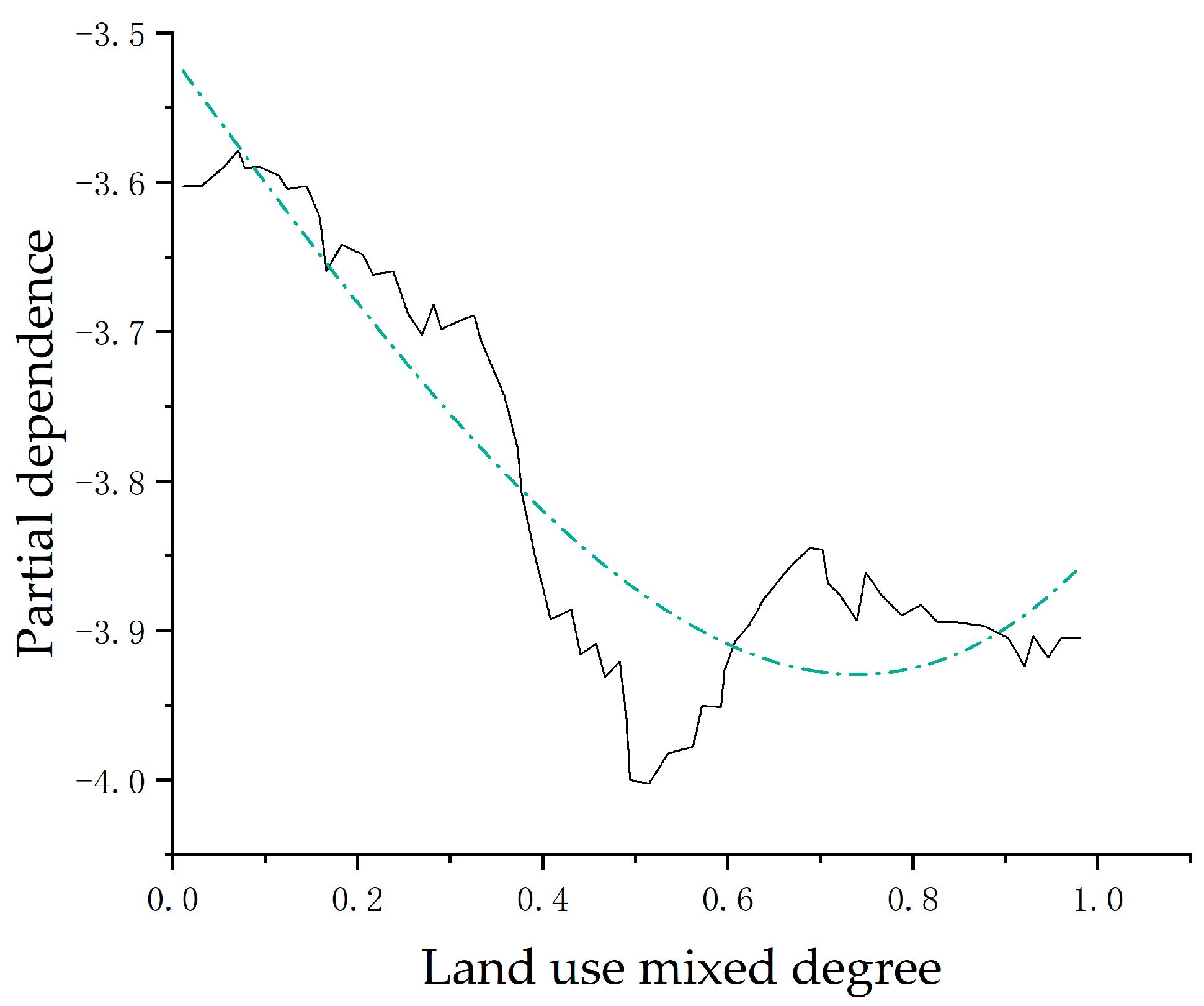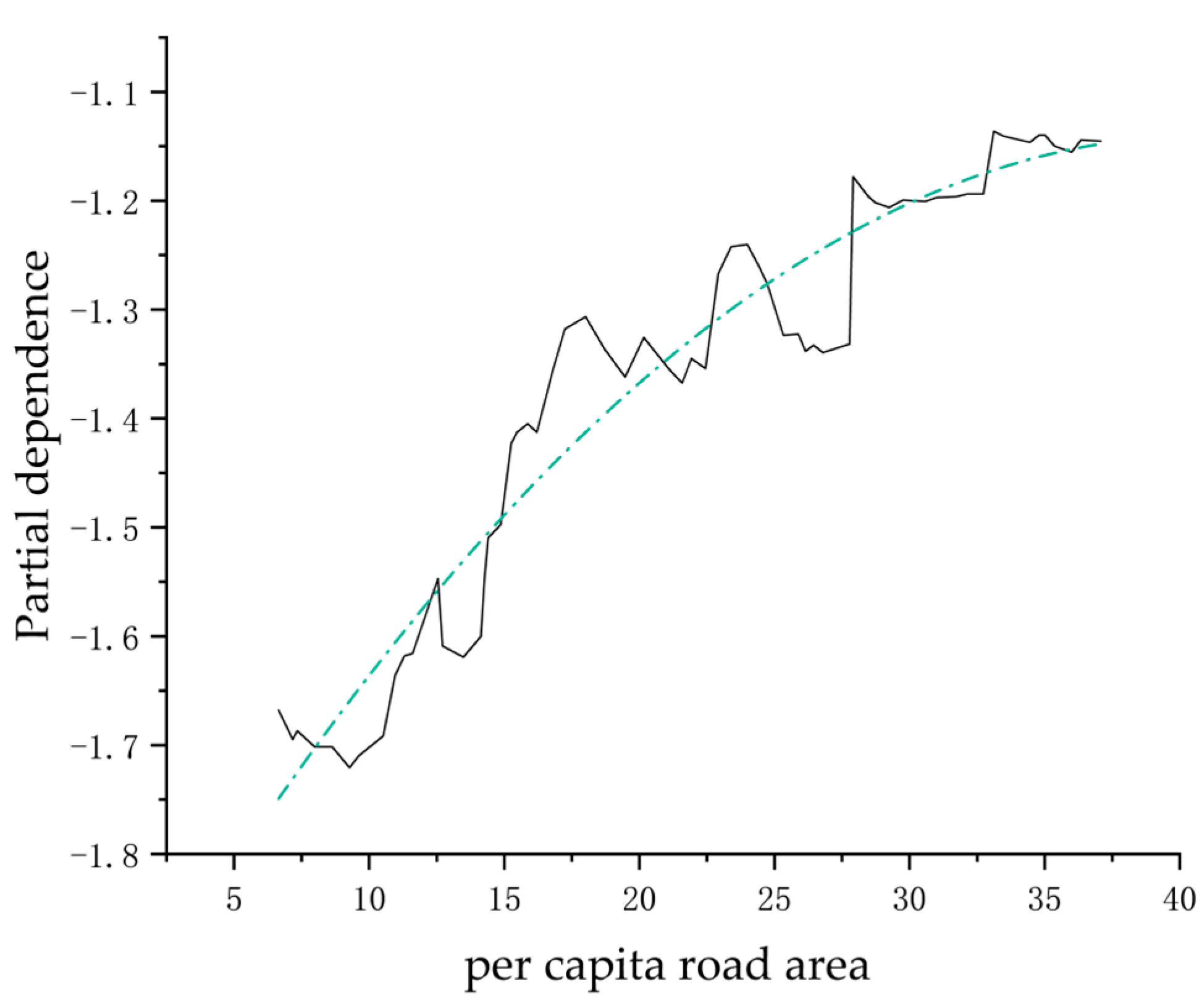Car Ownership Behavior Model Considering Nonlinear Impacts of Multi-Scale Built Environment Characteristics
Abstract
1. Introduction
2. Research Data
3. Model Construction
4. Results
4.1. The Impact of the Built Environment on Car Ownership Behavior
4.2. Nonlinear Effects of the Built Environment on Car Ownership
5. Conclusions
6. Discussion
Author Contributions
Funding
Institutional Review Board Statement
Informed Consent Statement
Data Availability Statement
Conflicts of Interest
References
- Yan, X.; Li, S.; Dong, R.; Li, G. Study on Influencing Factors of the Duration of Residential Leisure Travel to Urban Parks. J. Adv. Transp. 2022, 2022, 5943529. [Google Scholar] [CrossRef]
- Ding, C.; Zhang, H.; Yang, L.Y.; Cao, X. Analysis of the research problem on the synergistic effect between the built environment and transportation demand management. J. Hum. Settl. West China 2021, 36, 45–51. [Google Scholar] [CrossRef]
- Du, Q.; Zhou, Y.Q.; Huang, Y.D.; Wang, Y.; Bai, L. Spatiotemporal exploration of the non-linear impacts of accessibility on metro ridership. J. Transp. Geogr. 2022, 102, 103380. [Google Scholar] [CrossRef]
- Van Wee, B.; Handy, S. Key research themes on urban space, scale, and sustainable urban mobility. Int. J. Sustain. Transp. 2016, 10, 18–24. [Google Scholar] [CrossRef]
- Chen, J.; Liu, K.L.; Di, J.; Tao, P. Nonlinear Model of Impact of Built Environment on Urban Parking Demand. J. Transp. Syst. Eng. Inf. Technol. 2021, 21, 197–203. [Google Scholar] [CrossRef]
- Ding, C.; Wang, D.; Liu, C.; Zhang, Y.; Yang, J. Exploring the influence of built environment on travel mode choice considering the mediating effects of car ownership and travel distance. Transp. Res. Part A Policy Pract. 2017, 100, 65–80. [Google Scholar] [CrossRef]
- Zang, P.; Qiu, H.; Xian, F.; Yang, L.; Qiu, Y.; Guo, H. Nonlinear Effects of the Built Environment on Light Physical Activity among Older Adults: The Case of Lanzhou, China. Int. J. Environ. Res. Public Health 2022, 19, 8848. [Google Scholar] [CrossRef]
- Zegras, C. The built environment and motor vehicle ownership and use: Evidence from Santiago de Chile. Urban Stud. 2010, 47, 1793–1817. [Google Scholar] [CrossRef]
- Ding, C.; Wang, Y.; Yang, J.; Liu, C.; Lin, Y. Spatial heterogeneous impact of built environment on household auto ownership levels: Evidence from analysis at traffic analysis zone scales. Transp. Lett. 2016, 8, 26–34. [Google Scholar] [CrossRef]
- Yang, L.Y.; Ding, C.; Ju, Y.; Yu, B. Driving as a commuting travel mode choice of car owners in urban China: Roles of the built environment. Cities 2021, 112, 103114. [Google Scholar] [CrossRef]
- Guan, X.D.; Wang, D.G. Influences of the built environment on travel: A household-based perspective. Transp. Res. Part A Policy Pract. 2019, 130, 710–724. [Google Scholar] [CrossRef]
- Anirudh, B.; Mazumder, T.N.; Das, A. Examining effects of city’s size and regional context on vehicle ownership levels in the Indian context. Transp. Res. Part D Transp. Environ. 2022, 108, 103279. [Google Scholar] [CrossRef]
- Shao, Q.F.; Zhang, W.J.; Cao, X.Y.; Yang, J. Nonlinear and interaction effects of land use and motorcycles/E-bikes on car ownership. Transp. Res. Part D Transp. Environ. 2022, 102, 103115. [Google Scholar] [CrossRef]
- Ding, C.; Wang, Y.P.; Tang, T.Q.; Mishra, S.; Liu, C. Joint analysis of the spatial impacts of built environment on car ownership and travel mode choice. Transp. Res. Part D Transp. Environ. 2018, 60, 28–40. [Google Scholar] [CrossRef]
- Cao, X.J.; Næss, P.; Wolday, F. Examining the effects of the built environment on auto ownership in two Norwegian urban regions. Transp. Res. Part D Transp. Environ. 2019, 67, 464–474. [Google Scholar]
- Shen, Q.; Chen, P.; Pan, H. Factors affecting car ownership and mode choice in rail transit-supported suburbs of a large Chinese city. Transp. Res. Part A Policy Pract. 2016, 94, 31–44. [Google Scholar] [CrossRef]
- Ding, C.; Cao, X. How does the built environment at residential and work locations affect car ownership? An application of cross-classified multilevel model. J. Transp. Geogr. 2019, 75, 37–45. [Google Scholar] [CrossRef]
- Gan, Z.X.; Yang, M.; Feng, T.; Timmermans, H.J. Examining the relationship between built environment and metro ridership at station-to-station level. Transp. Res. Part D Transp. Environ. 2020, 82, 102332. [Google Scholar] [CrossRef]
- Su, S.L.; Zhao, C.; Zhou, H.; Li, B.; Kang, M. Unraveling the relative contribution of TOD structural factors to metro ridership: A novel localized modeling approach with implications on spatial planning. J. Transp. Geogr. 2022, 100, 103308. [Google Scholar] [CrossRef]
- Huang, X.Y.; Cao, X.S.; Cao, J. The association between transit access and auto ownership: Evidence from Guangzhou, China. Transp. Plan. Technol. 2016, 39, 269–283. [Google Scholar] [CrossRef]
- Ding, C.; Liu, T.T.; Cao, X.Y.; Tian, L. Illustrating nonlinear effects of built environment attributes on housing renters’ transit commuting. Transp. Res. Part D Transp. Environ. 2022, 112, 103503. [Google Scholar] [CrossRef]
- Ding, C.; Cao, X.Y.; Yu, B.; Ju, Y. Non-linear associations between zonal built environment attributes and transit commuting mode choice accounting for spatial heterogeneity. Transp. Res. Part A 2021, 148, 22–35. [Google Scholar] [CrossRef]
- Chen, E.H.; Ye, Z.R.; Wu, H. Nonlinear effects of built environment on intermodal transit trips considering spatial heterogeneity. Transp. Res. Part D Transp. Environ. 2021, 90, 102677. [Google Scholar] [CrossRef]
- Yin, C.Y.; Shao, C.F.; Wang, X.Q.; Xiong, Z.; Cui, W. Influence of land use mix on non-work travel behavior based on modified entropy index. J. Beijing Jiao Tong Univ. 2018, 42, 92–97. [Google Scholar] [CrossRef]
- Li, S.X.; Zhao, P.J. Exploring car ownership and car use in neighborhoods near metro stations in Beijing: Does the neighborhood built environment matter? Transp. Res. Part D Transp. Environ. 2017, 56, 1–17. [Google Scholar] [CrossRef]
- Yin, C.Y.; Shao, C.F.; Wang, X.Q. Influence of land use mixture on travel mode choice. J. Beijing Univ. Technol. 2018, 44, 1227–1232. [Google Scholar]
- Sarkar, P.P.; Chunchu, M. Quantification and analysis of land-use effects on travel behavior in smaller Indian cities: Case study of Agartala. J. Urban Plan. Dev. 2016, 142, 04016009. [Google Scholar] [CrossRef]
- Zhang, W.J.; Lu, D.M.; Zhao, Y.J.; Luo, X.; Yin, J. Incorporating polycentric development and neighborhood life-circle planning for reducing driving in Beijing: Nonlinear and threshold analysis. Cities 2022, 121, 103488. [Google Scholar] [CrossRef]
- Shirgaokar, M. Expanding cities and vehicle use in India: Differing impacts of built environment factors on scooter and car use in Mumbai. Urban Stud. 2016, 53, 3296–3316. [Google Scholar] [CrossRef]
- Yin, C.Y.; Wang, X.Q.; Shao, C.F.; Ma, J. Exploring the Relationship between Built Environment and Commuting Mode Choice: Longitudinal Evidence from China. Int. J. Environ. Res. Public Health 2022, 19, 14149. [Google Scholar] [CrossRef]
- Yin, C.Y.; Shao, C.F.; Wang, X.Q. Exploring the impact of built environment on car use: Does living near urban rail transit matter? Transp. Lett. 2020, 12, 391–398. [Google Scholar] [CrossRef]
- Yin, C.; Yao, X.J.; Sun, B.D. Population density and obesity in rural China: Mediation effects of car ownership. Transp. Res. Part D Transp. Environ. 2022, 105, 103228. [Google Scholar] [CrossRef]
- Wang, X.Q.; Shao, C.F.; Yin, C.Y.; Dong, C.J. Capturing Car Ownership Behavior Considering Spatial Autocorrelation in Traffic Analysis Zones. J. Transp. Syst. Eng. Inf. Technol. 2019, 19, 28–32. [Google Scholar] [CrossRef]
- Yin, C.Y.; Shao, C.F.; Wang, X.Q. Influence of urban built environment on car commuting considering parking availability. J. Jilin Univ. (Eng. Technol. Ed.) 2019, 49, 714–719. [Google Scholar] [CrossRef]
- Doddamani, C.; Manoj, M. Analysis of the influences of built environment measures on household car and motorcycle ownership decisions in Hubli-Dharwad cities. Transportation 2023, 50, 205–243. [Google Scholar] [CrossRef]
- Yin, C.; Sun, B.D. Disentangling the effects of the built environment on car ownership: A multi-level analysis of Chinese cities. Cities 2018, 74, 188–195. [Google Scholar] [CrossRef]
- Zhang, W.J.; Zhao, Y.J.; Cao, X.J.; Lu, D.; Chai, Y. Nonlinear effect of accessibility on car ownership in Beijing: Pedestrian-scale neighborhood planning. Transp. Res. Part D Transp. Environ. 2020, 86, 102445. [Google Scholar] [CrossRef]
- Ao, Y.B.; Yang, D.J.; Chen, C.; Wang, Y. Exploring the effects of the rural built environment on household car ownership after controlling for preference and attitude: Evidence from Sichuan, China. J. Transp. Geogr. 2019, 74, 24–36. [Google Scholar] [CrossRef]
- Wang, X.Q.; Yin, C.Y.; Zhang, J.Y.; Shao, C.; Wang, S. Nonlinear effects of residential and workplace built environment on car dependence. J. Transp. Geogr. 2021, 96, 103207. [Google Scholar] [CrossRef]
- Wu, J.X.; Qian, Y.N.; Han, Y. Relationship between built environment and elderly active travel of based on group heterogeneity. J. Transp. Syst. Eng. Inf. Technol. 2022, 22, 194–201. [Google Scholar]
- Friedman, J.H. Greedy function approximation: A gradient boosting machine. Ann. Stat. 2001, 29, 1189–1232. [Google Scholar] [CrossRef]
- Tao, T.; Wu, X.Y.; Cao, J.; Fan, Y.; Das, K.; Ramaswami, A. Exploring the Nonlinear Relationship between the Built Environment and Active Travel in the Twin Cities. J. Plan. Educ. Res. 2020, 2020, 1–16. [Google Scholar] [CrossRef]
- Jiang, Y.; Gu, P.Q.; Chen, Y.L.; He, D.; Mao, Q. Influence of land use and street characteristics on car ownership and use: Evidence from Jinan, China. Transp. Res. Part D Transp. Environ. 2017, 52, 518–534. [Google Scholar] [CrossRef]
- Clark, B.; Chatterjee, K.; Melia, S. Changes in level of household car ownership: The role of life events and spatial context. Transportation 2016, 43, 565–599. [Google Scholar] [CrossRef]
- Zhang, J.; Yu, B.; Chikaraishi, M. Interdependences between household residential and car ownership behavior: A life history analysis. J. Transp. Geogr. 2014, 34, 165–174. [Google Scholar] [CrossRef]
- Sun, B.D.; Ermagun, A.; Dan, B. Built environmental impacts on commuting mode choice and distance: Evidence from Shanghai. Transp. Res. Part D Transp. Environ. 2017, 52, 441–453. [Google Scholar] [CrossRef]
- Mangold, M.; Zhao, P.; Haitao, H.; Mansourian, A. Geo-fence planning for dockless bike-sharing systems: A GIS-based multi-criteria decision analysis framework. Urban Inform. 2022, 1, 17. [Google Scholar] [CrossRef]
- Schumann, H.; Haitao, H.; Quddus, M. Passively generated big data for micro-mobility: State-of-the-art and future research directions. Transp. Res. Part D Transp. Environ. 2023, 121, 103795. [Google Scholar] [CrossRef]







| Variable | Description | Mean | SD |
|---|---|---|---|
| Individual level—personal family attributes | |||
| Gender | 1: male; 0: female | 0.48 | 0.5 |
| Age | Age of respondents | 40.92 | 12.17 |
| Education | 1: Primary; 2: Middle; 3: High; 4: University and above | 2.12 | 1.03 |
| Family size | Number of respondents’ family members | 4.50 | 1.96 |
| Number of members under 16 years old | Number of family members under 16 years old | 0.47 | 0.5 |
| Household Income (yearly) | Family annual income (10,000 RMB) | 6.38 | 13.14 |
| Neighborhood scale—built environment characteristics | |||
| Degree of mixed land use | Calculated based on 5 facilities: sports squares, libraries, hospital clinics, schools and banks. | 0.61 | 0.3 |
| Distance to bus station | Walking distance to the nearest bus station (km) | 2.21 | 5.27 |
| Distance to city center | Distance from residence to the center of city (km) | 4.79 | 6.79 |
| Neighborhood Population density | Ratio of neighborhood population to neighborhood area (10,000 persons/km2) | 1.11 | 5.44 |
| City scale—built environment characteristics | |||
| City population density | Ratio of urban resident population to urban built-up area (10,000 persons/km2) | 0.21 | 0.3 |
| Whether there is a subway | 1: Yes; 0: No | 0.26 | 0.44 |
| The number of buses per 10,000 people | Number of buses per 10,000 people (Vehicles) | 10.89 | 11.77 |
| Road area per capita | Ratio of urban road area to urban resident population (m2/person) | 16.85 | 9.03 |
| Variable | VIF | Tolerance |
|---|---|---|
| Individual level—personal family attributes | ||
| Gender | 1.03 | 0.97 |
| Age | 1.45 | 0.69 |
| Education | 1.43 | 0.70 |
| Family size | 1.58 | 0.63 |
| Number of members under 16 years old | 1.58 | 0.63 |
| Income(yearly) | 1.04 | 0.96 |
| Neighborhood scale—built environment characteristics | ||
| Degree of mixed land use | 1.03 | 0.97 |
| Distance to bus station | 1.11 | 0.90 |
| Distance to city center | 1.1 | 0.91 |
| Neighborhood population density | 1.02 | 0.98 |
| City scale-built environment characteristics | ||
| City population density | 1.06 | 0.94 |
| Whether there is a subway | 1.36 | 0.74 |
| The number of buses per ten thousand people | 1.41 | 0.71 |
| Road area per capita | 1.18 | 0.85 |
| Variable | Rank | Relative Contribution (%) |
|---|---|---|
| Individual level—personal family attributes | ||
| Gender | 14 | 0.45 |
| Age | 5 | 7.86 |
| Education | 11 | 3.63 |
| Family size | 7 | 6.62 |
| Number of members under 16 years old | 12 | 3.46 |
| Income(yearly) | 1 | 24.28 |
| Sum of relative contribution | 46.3 | |
| Neighborhood scale—built environment characteristics | ||
| Degree of mixed land use | 8 | 6.51 |
| Distance to bus station | 4 | 8.32 |
| Distance to city center | 3 | 9.47 |
| Neighborhood population density | 2 | 9.64 |
| Sum of relative contribution | 33.94 | |
| City scale—built environment characteristics | ||
| City population density | 9 | 6.20 |
| Whether there is a subway | 13 | 0.73 |
| The number of buses per ten thousand people | 6 | 7.18 |
| Road area per capita | 10 | 5.65 |
| Sum of relative contribution | 19.76 | |
Disclaimer/Publisher’s Note: The statements, opinions and data contained in all publications are solely those of the individual author(s) and contributor(s) and not of MDPI and/or the editor(s). MDPI and/or the editor(s) disclaim responsibility for any injury to people or property resulting from any ideas, methods, instructions or products referred to in the content. |
© 2023 by the authors. Licensee MDPI, Basel, Switzerland. This article is an open access article distributed under the terms and conditions of the Creative Commons Attribution (CC BY) license (https://creativecommons.org/licenses/by/4.0/).
Share and Cite
Wu, L.; Yuan, X.; Yin, C.; Yang, M.; Ouyang, H. Car Ownership Behavior Model Considering Nonlinear Impacts of Multi-Scale Built Environment Characteristics. Sustainability 2023, 15, 9658. https://doi.org/10.3390/su15129658
Wu L, Yuan X, Yin C, Yang M, Ouyang H. Car Ownership Behavior Model Considering Nonlinear Impacts of Multi-Scale Built Environment Characteristics. Sustainability. 2023; 15(12):9658. https://doi.org/10.3390/su15129658
Chicago/Turabian StyleWu, Lan, Xiaorui Yuan, Chaoyin Yin, Ming Yang, and Hongjian Ouyang. 2023. "Car Ownership Behavior Model Considering Nonlinear Impacts of Multi-Scale Built Environment Characteristics" Sustainability 15, no. 12: 9658. https://doi.org/10.3390/su15129658
APA StyleWu, L., Yuan, X., Yin, C., Yang, M., & Ouyang, H. (2023). Car Ownership Behavior Model Considering Nonlinear Impacts of Multi-Scale Built Environment Characteristics. Sustainability, 15(12), 9658. https://doi.org/10.3390/su15129658





